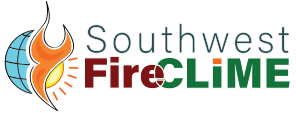
Resource Catalog
Document
Type: Journal Article
Publication Date: 1990
Fire scar and tree growth chronologies (1700 to 1905) and fire statistics (since 1905) from Arizona and New Mexico show that small areas burn after wet springs associated with the low phase of the Southern Oscillation (SO), whereas large areas burn after dry springs associated with the high phase of the SO. Through its synergistic influence on spring weather and fuel conditions, climatic variability in the tropical Pacific significantly influences vegetation dynamics in the southwestern United States. Synchrony of fire-free and severe fire years across diverse southwestern forests implies that climate forces fire regimes on a subcontinental scale; it also underscores the importance of exogenous factors in ecosystem dynamics.
Online Links
Citation: Swetnam, Thomas W.; Betancourt, Julio L. 1990. Fire-southern oscillation relations in the southwestern United States. Science 249(4972):1017-1020.
Cataloging Information
Regions:
Partner Sites:
Keywords:
- Arizona
- catastrophic fires
- climate impacts
- coniferous forests
- dendrochronology
- ecosystem dynamics
- ENSO - El Nino Southern Oscillation
- fire exclusion
- fire injuries (plants)
- fire regimes
- fire scar analysis
- fire size
- fuel accumulation
- fuel moisture
- habitat conversion
- human caused fires
- lightning caused fires
- mosaic
- national forests
- New Mexico
- pine forests
- Pinus edulis
- Pinus ponderosa
- Pinus strobiformis
- plant growth
- post-fire recovery
- precipitation
- Pseudotsuga menziesii
- season of fire
- seasonal activities
- shrublands
- Southern Oscillation
- statistical analysis
- Texas
- vegetation dynamics
- weather observations
- wildfires
Tall Timbers Record Number: 6764 • Location Status: In-file • Call Number: Fire File • Abstract Status: Fair use, Okay, Reproduced by permission
Record Last Modified:
Record Maintained By: FRAMES Staff (https://www.frames.gov/contact)
FRAMES Record Number: 32665

This bibliographic record was either created or modified by Tall Timbers and is provided without charge to promote research and education in Fire Ecology. The E.V. Komarek Fire Ecology Database is the intellectual property of Tall Timbers.

This document is part of the Southwest FireCLIME Annotated Bibliography, which includes published research related to the interactions between climate change, wildfire, and subsequent ecosystem effects in the southwestern U.S. The publications contained in the Bibliography have each been summarized to distill the outcomes as they pertain to fire and climate. Go to this document's record in the Southwest FireCLIME Annotated Bibliography.